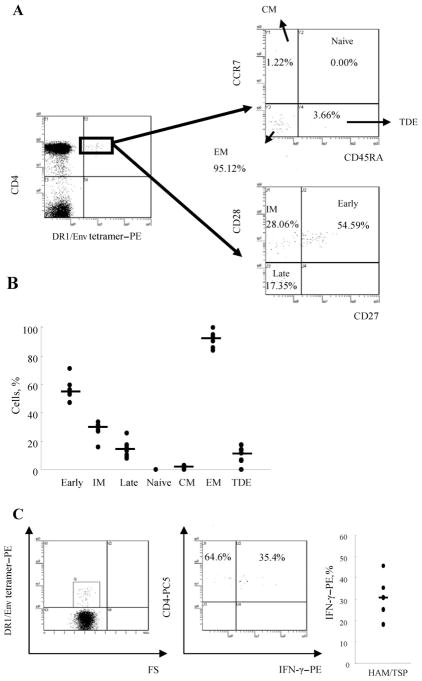Figure 4.
Phenotypic analysis of human T lymphotropic virus type 1 (HTLV-1) Env380 –399 –specific CD4+ T cells by HLA class II tetramer staining. A, Peripheral blood mononuclear cells from 7 patients with HTLV-1–associated myelopathy/tropical spastic paraparesis (HAM/TSP) were stained with cell-surface markers of memory (CD45RA), lymph node homing (CCR7), and costimulation (CD27 and CD28). One representative result is shown. The expression of CCR7 and CD45RA in DRB1*0101/Env380-394 (DR1/Env) tetramer+CD4+ T cells indicates that the vast majority of DR1/Env tetramer+CD4+ T cells were effector memory (EM; CCR7−CD45RA−) cells. The expression of CD27 and CD28 in DR1/Env tetramer+CD4+ T cells indicated that the majority of HTLV-1–specific CD4+ T cells were skewed to an early (54.59%) to intermediate (IM; 28.06%) memory phenotype. B, Ex vivo phenotypic profile of HTLV-1 Env380 –399 –specific CD4+ T cells in 7 patients with HAM/TSP. Each dot represents the percentage of DR1/Env tetramer+CD4+ T cells that showed the indicated phenotype (early, CD28+CD27+; IM, CD28+CD27−; late, CD28−CD27−; central memory [CM], CCR7+CD45RA−; EM, CCR7−CD45RA−; and terminary differentiated effector [TDE], CCR7−CD45RA+). Means are represented by horizontal lines. C, Interferon (IFN)–γ expression in DRB1*0101/Env380-394 tetramer+ cells. IFN-γ was detected in tetramer+ cells in all 5 patients with HAM/TSP tested. More than half of DR1/Env tetramer+CD4+ T cells did not express IFN-γ (for IFN-γ+tetramer+ cells, mean ± SD of 32.47% ± 12.76% and median of 31.03%). At least 500 DR1/Env tetramer+CD4+ cells were analyzed for each sample.

